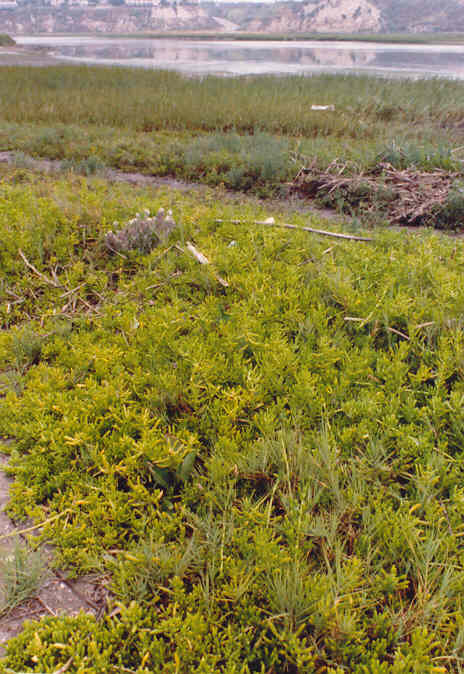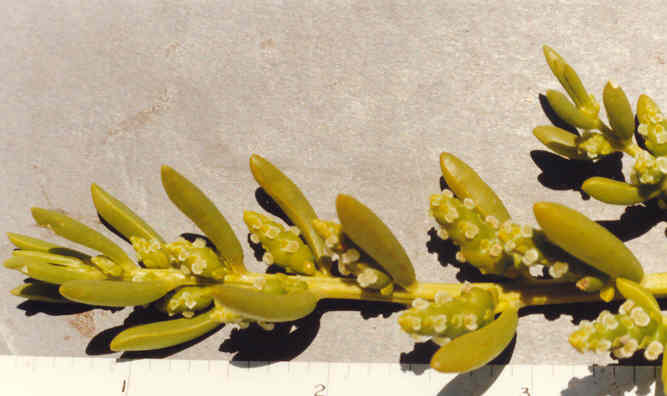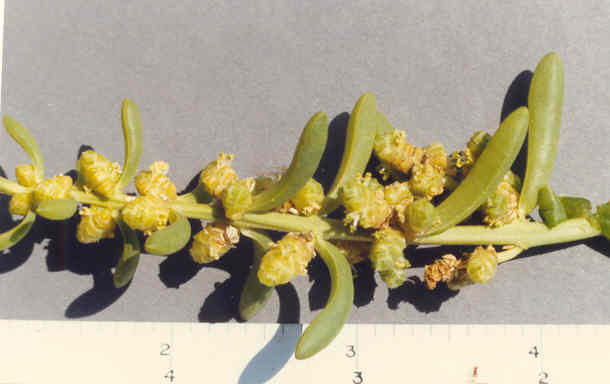
Batis maritima L.
Bataceae (Saltwort Family)
Native
Saltwort
American Saltwort
 |
Batis maritima L.Bataceae (Saltwort Family)Native
SaltwortAmerican Saltwort
|
June Photo
Plant Characteristics:
Low bushy plant; stems prostrate or ascending, woody at base, 1-10 dm.
long, glabrous; lvs. opposite, entire, fleshy, subterete, linear-oblanceolate,
1-2 cm. long, stipulate, with a small basal loose flange; staminate fls. with
2-lobed calyx shorter than bracts; stamens 4, exserted, longer than the white
triangular staminodia; spikes sessile, ovoid-cylindric, 5-10 mm. long; bracts
rounded, broader than long; female spikes short-peduncled, ca. 1 cm. long in
fr., without calyx or corolla, consisting of a 4-loculed ovary with solitary
ovule in each locule, and a sessile capitate stigma; pistils coalescent to form
a fleshy fruit.
Habitat:
Coastal Strand, Coastal Salt Marsh; Ventura Co. to L. Calif.; W.I.,
Atlantic Coast, S. Am. July-Oct.
Name:
Greek name of some seashore plant. (Munz,
Flora So. Calif. 242).
Latin, maritimus, of or
belonging to the sea. (Jaeger 150).
General:
Very common in the study area. Photographed
at North Star Beach, the Santa Ana Heights Flats and on the dike below the old
Salt Works. One of the native
halophytes in upper Newport Bay. For a complete list of the halophytes see Spartina
foliosa, (my comments).
It is rare to witness large-scale replacement of salt marsh by freshwater
marsh. However, exactly that
occurred at the mouth of the San Diego River in 1980 when natural floods were
followed by deliberate release of water from El Capitan Reservoir.
Large areas of pickleweed-dominated salt marsh vegetation at the seaward
end of the river were killed. Leaching
reduced soil salinities to 0 ppt. in many parts of the marsh and seeds of
freshwater marsh species, brought downstream by the floodwaters, germinated
rapidly. Cattails developed a nearly continuous, tall, robust canopy
within two to three months after flooding.
Dominance by freshwater species was short lived, however, because the
freshwater input ceased and the tides resumed their role as the major water
source. By July 1981 nearly all the
cattails had died and the marsh was a uniform canopy of standing dead
vegetation. At this time a few
patches of salt marsh vegetation were visible; some of these were cordgrass, Spartina
foliosa, and others were Jaumea
carnosa and Batis maritima which,
either survived the floods or germinated shortly after. All three species began expanding vegetatively following the
demise of the cattails, and may produce a dense canopy before pickleweed is able
to re-invade by seed and dominate the area. (Zedler 37).
Zedler reports that 70% or more of the populations of this species can be
expected to occur within 4.9 to 5.6 ft. above MLLW. (Zedler 17). Delfina Cuero, a Kumeyaay or Southern
Diegueno Indian, made the following comment about Batis
maritima in her autobiography: "The
leaves and stems can be chewed fresh for the water in them, or they are boiled
and eaten as a vegetable." (Shipek 86).
A single genus of warmer parts of the world.
(Munz, Flora So. Calif. 242).
Text Ref:
Hickman, Ed. 362; Munz, Flora So.
Calif. 242; Roberts 14.
Photo Ref:
May 5 83 # 14; May-June 85 # 17; June 1 86 # 23; May-June 92 # 21.
Identity: by R. De Ruff.
First Found: May 1983.
Computer
Ref:
Plant Data 201.
No plant specimen.
Last edit 6/5/04.
 |
 |
June Photo December Photo